Impact of family influence on children’s health and well-being
VerifiedAdded on 2023/01/13
|6
|3012
|21
AI Summary
This case study explores the impact of family influence on children’s health and well-being, focusing on the example of Atta, a 4-year-old child who is obese. It discusses the socialization influences, strategies for early childhood staff and leadership, environmental influences, and equity issues that contribute to the wellness and well-being issues outlined in the case study. The case study emphasizes the importance of promoting healthy behaviors and providing opportunities for physical activity in early childhood settings.
Contribute Materials
Your contribution can guide someone’s learning journey. Share your
documents today.
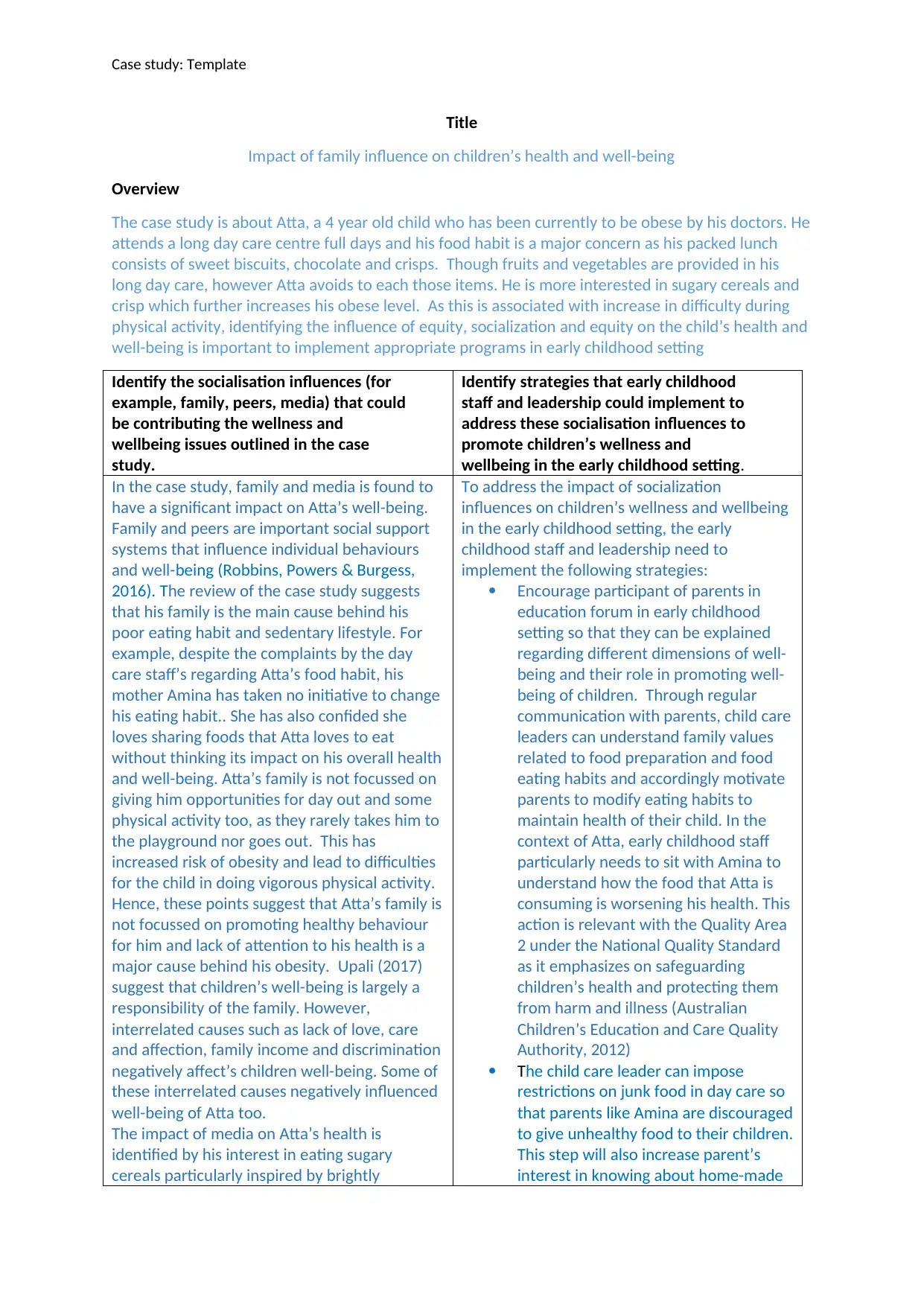
Case study: Template
Title
Impact of family influence on children’s health and well-being
Overview
The case study is about Atta, a 4 year old child who has been currently to be obese by his doctors. He
attends a long day care centre full days and his food habit is a major concern as his packed lunch
consists of sweet biscuits, chocolate and crisps. Though fruits and vegetables are provided in his
long day care, however Atta avoids to each those items. He is more interested in sugary cereals and
crisp which further increases his obese level. As this is associated with increase in difficulty during
physical activity, identifying the influence of equity, socialization and equity on the child’s health and
well-being is important to implement appropriate programs in early childhood setting
Identify the socialisation influences (for
example, family, peers, media) that could
be contributing the wellness and
wellbeing issues outlined in the case
study.
Identify strategies that early childhood
staff and leadership could implement to
address these socialisation influences to
promote children’s wellness and
wellbeing in the early childhood setting.
In the case study, family and media is found to
have a significant impact on Atta’s well-being.
Family and peers are important social support
systems that influence individual behaviours
and well-being (Robbins, Powers & Burgess,
2016). The review of the case study suggests
that his family is the main cause behind his
poor eating habit and sedentary lifestyle. For
example, despite the complaints by the day
care staff’s regarding Atta’s food habit, his
mother Amina has taken no initiative to change
his eating habit.. She has also confided she
loves sharing foods that Atta loves to eat
without thinking its impact on his overall health
and well-being. Atta’s family is not focussed on
giving him opportunities for day out and some
physical activity too, as they rarely takes him to
the playground nor goes out. This has
increased risk of obesity and lead to difficulties
for the child in doing vigorous physical activity.
Hence, these points suggest that Atta’s family is
not focussed on promoting healthy behaviour
for him and lack of attention to his health is a
major cause behind his obesity. Upali (2017)
suggest that children’s well-being is largely a
responsibility of the family. However,
interrelated causes such as lack of love, care
and affection, family income and discrimination
negatively affect’s children well-being. Some of
these interrelated causes negatively influenced
well-being of Atta too.
The impact of media on Atta’s health is
identified by his interest in eating sugary
cereals particularly inspired by brightly
To address the impact of socialization
influences on children’s wellness and wellbeing
in the early childhood setting, the early
childhood staff and leadership need to
implement the following strategies:
Encourage participant of parents in
education forum in early childhood
setting so that they can be explained
regarding different dimensions of well-
being and their role in promoting well-
being of children. Through regular
communication with parents, child care
leaders can understand family values
related to food preparation and food
eating habits and accordingly motivate
parents to modify eating habits to
maintain health of their child. In the
context of Atta, early childhood staff
particularly needs to sit with Amina to
understand how the food that Atta is
consuming is worsening his health. This
action is relevant with the Quality Area
2 under the National Quality Standard
as it emphasizes on safeguarding
children’s health and protecting them
from harm and illness (Australian
Children’s Education and Care Quality
Authority, 2012)
The child care leader can impose
restrictions on junk food in day care so
that parents like Amina are discouraged
to give unhealthy food to their children.
This step will also increase parent’s
interest in knowing about home-made
Title
Impact of family influence on children’s health and well-being
Overview
The case study is about Atta, a 4 year old child who has been currently to be obese by his doctors. He
attends a long day care centre full days and his food habit is a major concern as his packed lunch
consists of sweet biscuits, chocolate and crisps. Though fruits and vegetables are provided in his
long day care, however Atta avoids to each those items. He is more interested in sugary cereals and
crisp which further increases his obese level. As this is associated with increase in difficulty during
physical activity, identifying the influence of equity, socialization and equity on the child’s health and
well-being is important to implement appropriate programs in early childhood setting
Identify the socialisation influences (for
example, family, peers, media) that could
be contributing the wellness and
wellbeing issues outlined in the case
study.
Identify strategies that early childhood
staff and leadership could implement to
address these socialisation influences to
promote children’s wellness and
wellbeing in the early childhood setting.
In the case study, family and media is found to
have a significant impact on Atta’s well-being.
Family and peers are important social support
systems that influence individual behaviours
and well-being (Robbins, Powers & Burgess,
2016). The review of the case study suggests
that his family is the main cause behind his
poor eating habit and sedentary lifestyle. For
example, despite the complaints by the day
care staff’s regarding Atta’s food habit, his
mother Amina has taken no initiative to change
his eating habit.. She has also confided she
loves sharing foods that Atta loves to eat
without thinking its impact on his overall health
and well-being. Atta’s family is not focussed on
giving him opportunities for day out and some
physical activity too, as they rarely takes him to
the playground nor goes out. This has
increased risk of obesity and lead to difficulties
for the child in doing vigorous physical activity.
Hence, these points suggest that Atta’s family is
not focussed on promoting healthy behaviour
for him and lack of attention to his health is a
major cause behind his obesity. Upali (2017)
suggest that children’s well-being is largely a
responsibility of the family. However,
interrelated causes such as lack of love, care
and affection, family income and discrimination
negatively affect’s children well-being. Some of
these interrelated causes negatively influenced
well-being of Atta too.
The impact of media on Atta’s health is
identified by his interest in eating sugary
cereals particularly inspired by brightly
To address the impact of socialization
influences on children’s wellness and wellbeing
in the early childhood setting, the early
childhood staff and leadership need to
implement the following strategies:
Encourage participant of parents in
education forum in early childhood
setting so that they can be explained
regarding different dimensions of well-
being and their role in promoting well-
being of children. Through regular
communication with parents, child care
leaders can understand family values
related to food preparation and food
eating habits and accordingly motivate
parents to modify eating habits to
maintain health of their child. In the
context of Atta, early childhood staff
particularly needs to sit with Amina to
understand how the food that Atta is
consuming is worsening his health. This
action is relevant with the Quality Area
2 under the National Quality Standard
as it emphasizes on safeguarding
children’s health and protecting them
from harm and illness (Australian
Children’s Education and Care Quality
Authority, 2012)
The child care leader can impose
restrictions on junk food in day care so
that parents like Amina are discouraged
to give unhealthy food to their children.
This step will also increase parent’s
interest in knowing about home-made
Secure Best Marks with AI Grader
Need help grading? Try our AI Grader for instant feedback on your assignments.
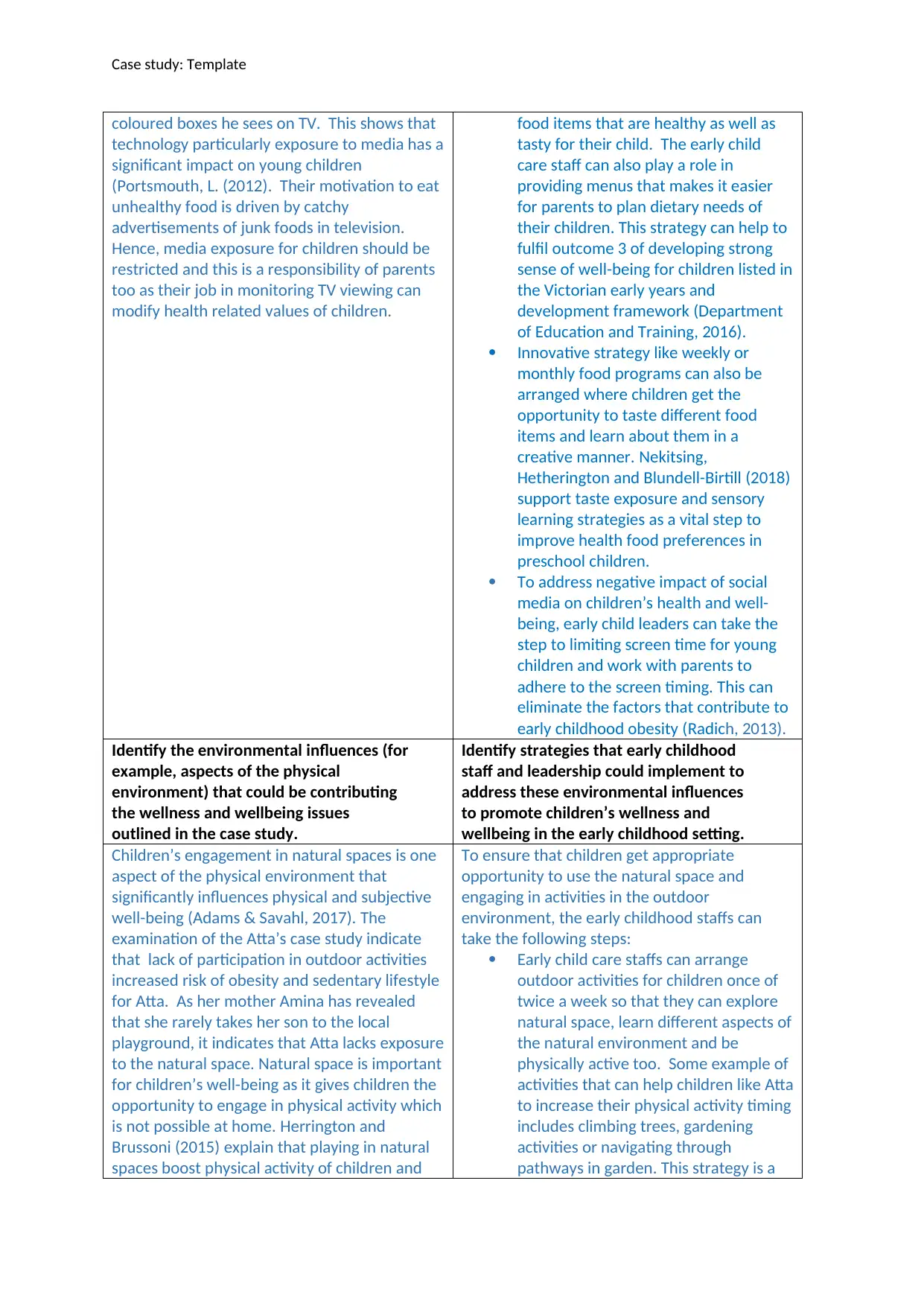
Case study: Template
coloured boxes he sees on TV. This shows that
technology particularly exposure to media has a
significant impact on young children
(Portsmouth, L. (2012). Their motivation to eat
unhealthy food is driven by catchy
advertisements of junk foods in television.
Hence, media exposure for children should be
restricted and this is a responsibility of parents
too as their job in monitoring TV viewing can
modify health related values of children.
food items that are healthy as well as
tasty for their child. The early child
care staff can also play a role in
providing menus that makes it easier
for parents to plan dietary needs of
their children. This strategy can help to
fulfil outcome 3 of developing strong
sense of well-being for children listed in
the Victorian early years and
development framework (Department
of Education and Training, 2016).
Innovative strategy like weekly or
monthly food programs can also be
arranged where children get the
opportunity to taste different food
items and learn about them in a
creative manner. Nekitsing,
Hetherington and Blundell-Birtill (2018)
support taste exposure and sensory
learning strategies as a vital step to
improve health food preferences in
preschool children.
To address negative impact of social
media on children’s health and well-
being, early child leaders can take the
step to limiting screen time for young
children and work with parents to
adhere to the screen timing. This can
eliminate the factors that contribute to
early childhood obesity (Radich, 2013).
Identify the environmental influences (for
example, aspects of the physical
environment) that could be contributing
the wellness and wellbeing issues
outlined in the case study.
Identify strategies that early childhood
staff and leadership could implement to
address these environmental influences
to promote children’s wellness and
wellbeing in the early childhood setting.
Children’s engagement in natural spaces is one
aspect of the physical environment that
significantly influences physical and subjective
well-being (Adams & Savahl, 2017). The
examination of the Atta’s case study indicate
that lack of participation in outdoor activities
increased risk of obesity and sedentary lifestyle
for Atta. As her mother Amina has revealed
that she rarely takes her son to the local
playground, it indicates that Atta lacks exposure
to the natural space. Natural space is important
for children’s well-being as it gives children the
opportunity to engage in physical activity which
is not possible at home. Herrington and
Brussoni (2015) explain that playing in natural
spaces boost physical activity of children and
To ensure that children get appropriate
opportunity to use the natural space and
engaging in activities in the outdoor
environment, the early childhood staffs can
take the following steps:
Early child care staffs can arrange
outdoor activities for children once of
twice a week so that they can explore
natural space, learn different aspects of
the natural environment and be
physically active too. Some example of
activities that can help children like Atta
to increase their physical activity timing
includes climbing trees, gardening
activities or navigating through
pathways in garden. This strategy is a
coloured boxes he sees on TV. This shows that
technology particularly exposure to media has a
significant impact on young children
(Portsmouth, L. (2012). Their motivation to eat
unhealthy food is driven by catchy
advertisements of junk foods in television.
Hence, media exposure for children should be
restricted and this is a responsibility of parents
too as their job in monitoring TV viewing can
modify health related values of children.
food items that are healthy as well as
tasty for their child. The early child
care staff can also play a role in
providing menus that makes it easier
for parents to plan dietary needs of
their children. This strategy can help to
fulfil outcome 3 of developing strong
sense of well-being for children listed in
the Victorian early years and
development framework (Department
of Education and Training, 2016).
Innovative strategy like weekly or
monthly food programs can also be
arranged where children get the
opportunity to taste different food
items and learn about them in a
creative manner. Nekitsing,
Hetherington and Blundell-Birtill (2018)
support taste exposure and sensory
learning strategies as a vital step to
improve health food preferences in
preschool children.
To address negative impact of social
media on children’s health and well-
being, early child leaders can take the
step to limiting screen time for young
children and work with parents to
adhere to the screen timing. This can
eliminate the factors that contribute to
early childhood obesity (Radich, 2013).
Identify the environmental influences (for
example, aspects of the physical
environment) that could be contributing
the wellness and wellbeing issues
outlined in the case study.
Identify strategies that early childhood
staff and leadership could implement to
address these environmental influences
to promote children’s wellness and
wellbeing in the early childhood setting.
Children’s engagement in natural spaces is one
aspect of the physical environment that
significantly influences physical and subjective
well-being (Adams & Savahl, 2017). The
examination of the Atta’s case study indicate
that lack of participation in outdoor activities
increased risk of obesity and sedentary lifestyle
for Atta. As her mother Amina has revealed
that she rarely takes her son to the local
playground, it indicates that Atta lacks exposure
to the natural space. Natural space is important
for children’s well-being as it gives children the
opportunity to engage in physical activity which
is not possible at home. Herrington and
Brussoni (2015) explain that playing in natural
spaces boost physical activity of children and
To ensure that children get appropriate
opportunity to use the natural space and
engaging in activities in the outdoor
environment, the early childhood staffs can
take the following steps:
Early child care staffs can arrange
outdoor activities for children once of
twice a week so that they can explore
natural space, learn different aspects of
the natural environment and be
physically active too. Some example of
activities that can help children like Atta
to increase their physical activity timing
includes climbing trees, gardening
activities or navigating through
pathways in garden. This strategy is a
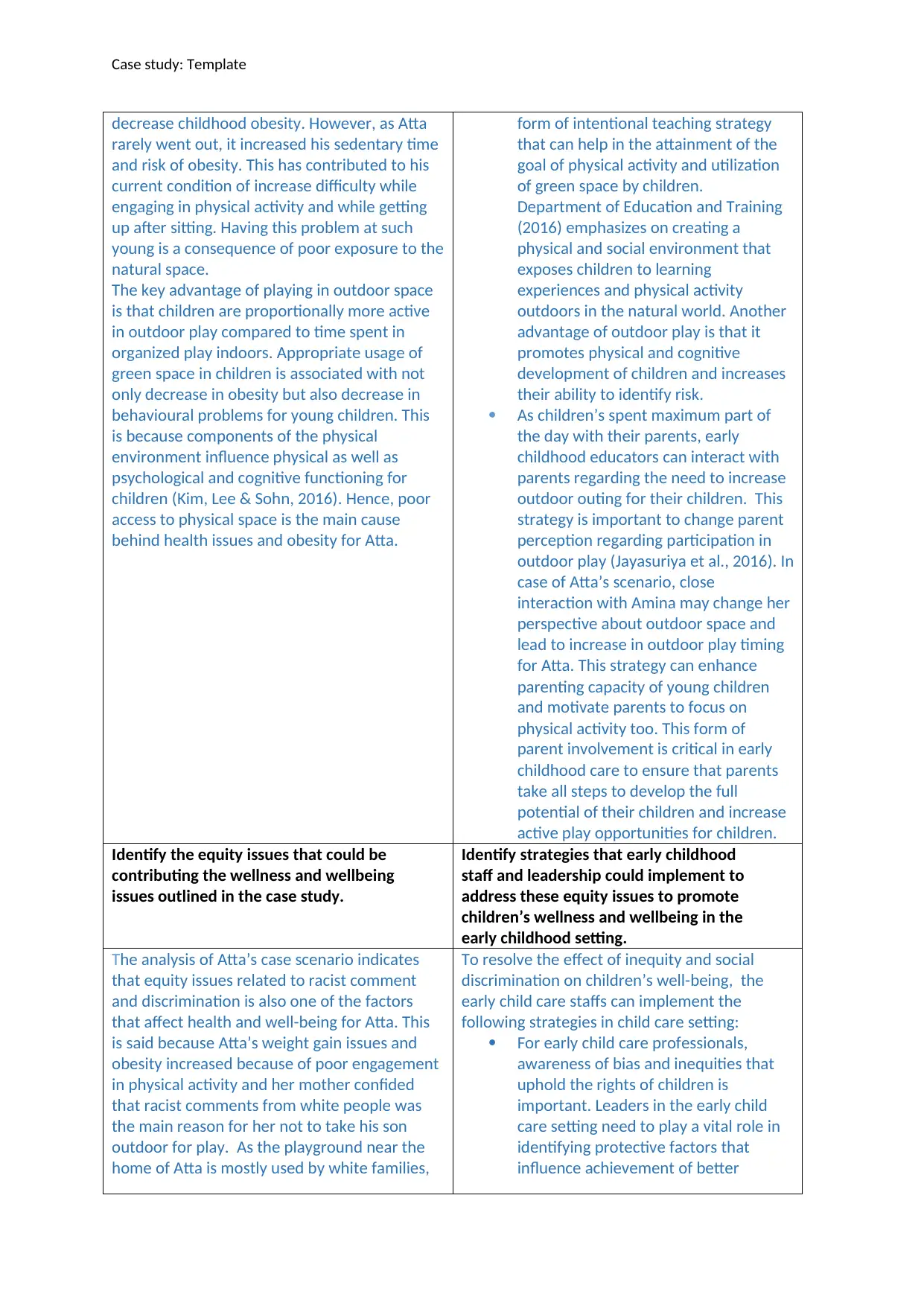
Case study: Template
decrease childhood obesity. However, as Atta
rarely went out, it increased his sedentary time
and risk of obesity. This has contributed to his
current condition of increase difficulty while
engaging in physical activity and while getting
up after sitting. Having this problem at such
young is a consequence of poor exposure to the
natural space.
The key advantage of playing in outdoor space
is that children are proportionally more active
in outdoor play compared to time spent in
organized play indoors. Appropriate usage of
green space in children is associated with not
only decrease in obesity but also decrease in
behavioural problems for young children. This
is because components of the physical
environment influence physical as well as
psychological and cognitive functioning for
children (Kim, Lee & Sohn, 2016). Hence, poor
access to physical space is the main cause
behind health issues and obesity for Atta.
form of intentional teaching strategy
that can help in the attainment of the
goal of physical activity and utilization
of green space by children.
Department of Education and Training
(2016) emphasizes on creating a
physical and social environment that
exposes children to learning
experiences and physical activity
outdoors in the natural world. Another
advantage of outdoor play is that it
promotes physical and cognitive
development of children and increases
their ability to identify risk.
As children’s spent maximum part of
the day with their parents, early
childhood educators can interact with
parents regarding the need to increase
outdoor outing for their children. This
strategy is important to change parent
perception regarding participation in
outdoor play (Jayasuriya et al., 2016). In
case of Atta’s scenario, close
interaction with Amina may change her
perspective about outdoor space and
lead to increase in outdoor play timing
for Atta. This strategy can enhance
parenting capacity of young children
and motivate parents to focus on
physical activity too. This form of
parent involvement is critical in early
childhood care to ensure that parents
take all steps to develop the full
potential of their children and increase
active play opportunities for children.
Identify the equity issues that could be
contributing the wellness and wellbeing
issues outlined in the case study.
Identify strategies that early childhood
staff and leadership could implement to
address these equity issues to promote
children’s wellness and wellbeing in the
early childhood setting.
The analysis of Atta’s case scenario indicates
that equity issues related to racist comment
and discrimination is also one of the factors
that affect health and well-being for Atta. This
is said because Atta’s weight gain issues and
obesity increased because of poor engagement
in physical activity and her mother confided
that racist comments from white people was
the main reason for her not to take his son
outdoor for play. As the playground near the
home of Atta is mostly used by white families,
To resolve the effect of inequity and social
discrimination on children’s well-being, the
early child care staffs can implement the
following strategies in child care setting:
For early child care professionals,
awareness of bias and inequities that
uphold the rights of children is
important. Leaders in the early child
care setting need to play a vital role in
identifying protective factors that
influence achievement of better
decrease childhood obesity. However, as Atta
rarely went out, it increased his sedentary time
and risk of obesity. This has contributed to his
current condition of increase difficulty while
engaging in physical activity and while getting
up after sitting. Having this problem at such
young is a consequence of poor exposure to the
natural space.
The key advantage of playing in outdoor space
is that children are proportionally more active
in outdoor play compared to time spent in
organized play indoors. Appropriate usage of
green space in children is associated with not
only decrease in obesity but also decrease in
behavioural problems for young children. This
is because components of the physical
environment influence physical as well as
psychological and cognitive functioning for
children (Kim, Lee & Sohn, 2016). Hence, poor
access to physical space is the main cause
behind health issues and obesity for Atta.
form of intentional teaching strategy
that can help in the attainment of the
goal of physical activity and utilization
of green space by children.
Department of Education and Training
(2016) emphasizes on creating a
physical and social environment that
exposes children to learning
experiences and physical activity
outdoors in the natural world. Another
advantage of outdoor play is that it
promotes physical and cognitive
development of children and increases
their ability to identify risk.
As children’s spent maximum part of
the day with their parents, early
childhood educators can interact with
parents regarding the need to increase
outdoor outing for their children. This
strategy is important to change parent
perception regarding participation in
outdoor play (Jayasuriya et al., 2016). In
case of Atta’s scenario, close
interaction with Amina may change her
perspective about outdoor space and
lead to increase in outdoor play timing
for Atta. This strategy can enhance
parenting capacity of young children
and motivate parents to focus on
physical activity too. This form of
parent involvement is critical in early
childhood care to ensure that parents
take all steps to develop the full
potential of their children and increase
active play opportunities for children.
Identify the equity issues that could be
contributing the wellness and wellbeing
issues outlined in the case study.
Identify strategies that early childhood
staff and leadership could implement to
address these equity issues to promote
children’s wellness and wellbeing in the
early childhood setting.
The analysis of Atta’s case scenario indicates
that equity issues related to racist comment
and discrimination is also one of the factors
that affect health and well-being for Atta. This
is said because Atta’s weight gain issues and
obesity increased because of poor engagement
in physical activity and her mother confided
that racist comments from white people was
the main reason for her not to take his son
outdoor for play. As the playground near the
home of Atta is mostly used by white families,
To resolve the effect of inequity and social
discrimination on children’s well-being, the
early child care staffs can implement the
following strategies in child care setting:
For early child care professionals,
awareness of bias and inequities that
uphold the rights of children is
important. Leaders in the early child
care setting need to play a vital role in
identifying protective factors that
influence achievement of better
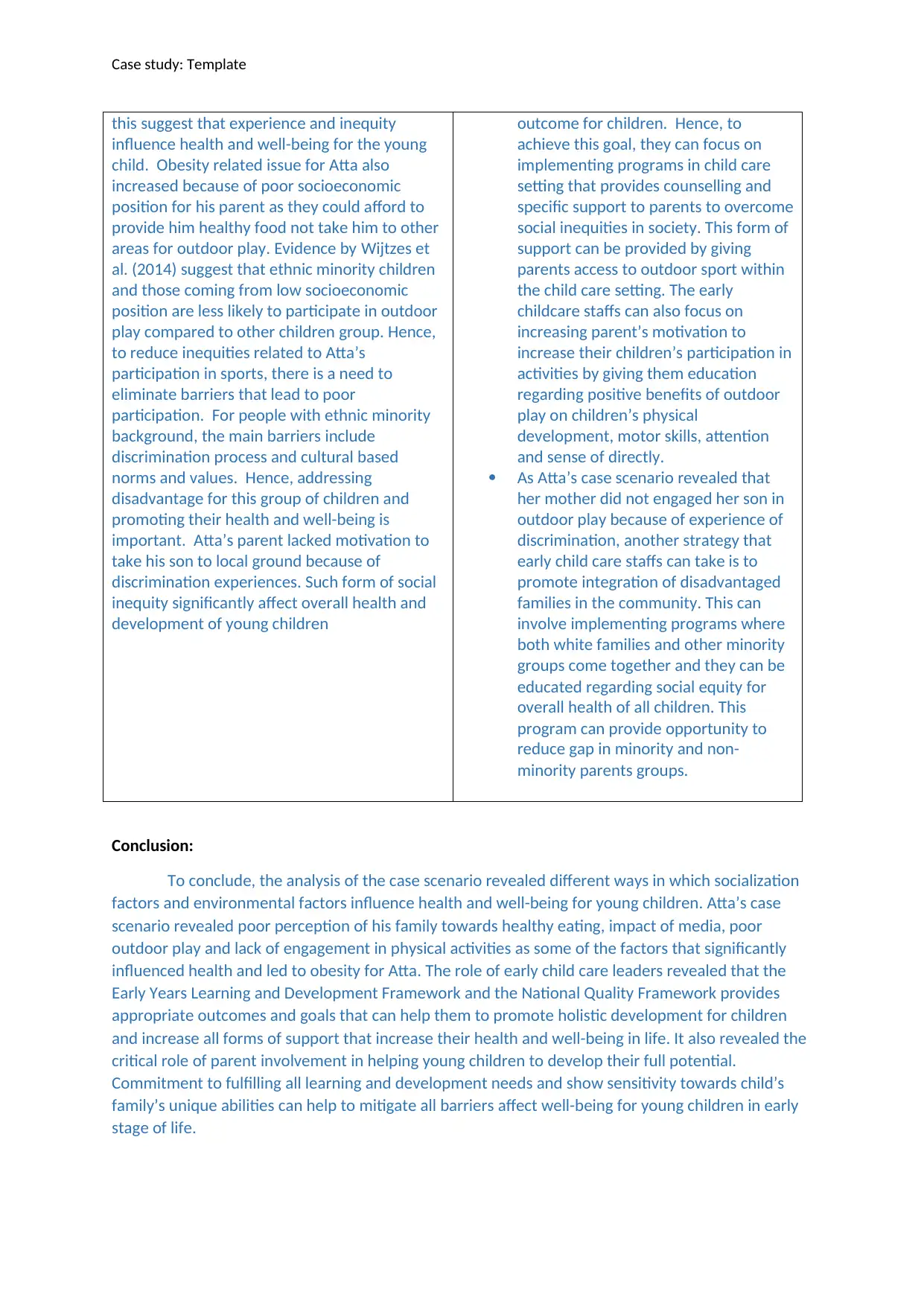
Case study: Template
this suggest that experience and inequity
influence health and well-being for the young
child. Obesity related issue for Atta also
increased because of poor socioeconomic
position for his parent as they could afford to
provide him healthy food not take him to other
areas for outdoor play. Evidence by Wijtzes et
al. (2014) suggest that ethnic minority children
and those coming from low socioeconomic
position are less likely to participate in outdoor
play compared to other children group. Hence,
to reduce inequities related to Atta’s
participation in sports, there is a need to
eliminate barriers that lead to poor
participation. For people with ethnic minority
background, the main barriers include
discrimination process and cultural based
norms and values. Hence, addressing
disadvantage for this group of children and
promoting their health and well-being is
important. Atta’s parent lacked motivation to
take his son to local ground because of
discrimination experiences. Such form of social
inequity significantly affect overall health and
development of young children
outcome for children. Hence, to
achieve this goal, they can focus on
implementing programs in child care
setting that provides counselling and
specific support to parents to overcome
social inequities in society. This form of
support can be provided by giving
parents access to outdoor sport within
the child care setting. The early
childcare staffs can also focus on
increasing parent’s motivation to
increase their children’s participation in
activities by giving them education
regarding positive benefits of outdoor
play on children’s physical
development, motor skills, attention
and sense of directly.
As Atta’s case scenario revealed that
her mother did not engaged her son in
outdoor play because of experience of
discrimination, another strategy that
early child care staffs can take is to
promote integration of disadvantaged
families in the community. This can
involve implementing programs where
both white families and other minority
groups come together and they can be
educated regarding social equity for
overall health of all children. This
program can provide opportunity to
reduce gap in minority and non-
minority parents groups.
Conclusion:
To conclude, the analysis of the case scenario revealed different ways in which socialization
factors and environmental factors influence health and well-being for young children. Atta’s case
scenario revealed poor perception of his family towards healthy eating, impact of media, poor
outdoor play and lack of engagement in physical activities as some of the factors that significantly
influenced health and led to obesity for Atta. The role of early child care leaders revealed that the
Early Years Learning and Development Framework and the National Quality Framework provides
appropriate outcomes and goals that can help them to promote holistic development for children
and increase all forms of support that increase their health and well-being in life. It also revealed the
critical role of parent involvement in helping young children to develop their full potential.
Commitment to fulfilling all learning and development needs and show sensitivity towards child’s
family’s unique abilities can help to mitigate all barriers affect well-being for young children in early
stage of life.
this suggest that experience and inequity
influence health and well-being for the young
child. Obesity related issue for Atta also
increased because of poor socioeconomic
position for his parent as they could afford to
provide him healthy food not take him to other
areas for outdoor play. Evidence by Wijtzes et
al. (2014) suggest that ethnic minority children
and those coming from low socioeconomic
position are less likely to participate in outdoor
play compared to other children group. Hence,
to reduce inequities related to Atta’s
participation in sports, there is a need to
eliminate barriers that lead to poor
participation. For people with ethnic minority
background, the main barriers include
discrimination process and cultural based
norms and values. Hence, addressing
disadvantage for this group of children and
promoting their health and well-being is
important. Atta’s parent lacked motivation to
take his son to local ground because of
discrimination experiences. Such form of social
inequity significantly affect overall health and
development of young children
outcome for children. Hence, to
achieve this goal, they can focus on
implementing programs in child care
setting that provides counselling and
specific support to parents to overcome
social inequities in society. This form of
support can be provided by giving
parents access to outdoor sport within
the child care setting. The early
childcare staffs can also focus on
increasing parent’s motivation to
increase their children’s participation in
activities by giving them education
regarding positive benefits of outdoor
play on children’s physical
development, motor skills, attention
and sense of directly.
As Atta’s case scenario revealed that
her mother did not engaged her son in
outdoor play because of experience of
discrimination, another strategy that
early child care staffs can take is to
promote integration of disadvantaged
families in the community. This can
involve implementing programs where
both white families and other minority
groups come together and they can be
educated regarding social equity for
overall health of all children. This
program can provide opportunity to
reduce gap in minority and non-
minority parents groups.
Conclusion:
To conclude, the analysis of the case scenario revealed different ways in which socialization
factors and environmental factors influence health and well-being for young children. Atta’s case
scenario revealed poor perception of his family towards healthy eating, impact of media, poor
outdoor play and lack of engagement in physical activities as some of the factors that significantly
influenced health and led to obesity for Atta. The role of early child care leaders revealed that the
Early Years Learning and Development Framework and the National Quality Framework provides
appropriate outcomes and goals that can help them to promote holistic development for children
and increase all forms of support that increase their health and well-being in life. It also revealed the
critical role of parent involvement in helping young children to develop their full potential.
Commitment to fulfilling all learning and development needs and show sensitivity towards child’s
family’s unique abilities can help to mitigate all barriers affect well-being for young children in early
stage of life.
Secure Best Marks with AI Grader
Need help grading? Try our AI Grader for instant feedback on your assignments.
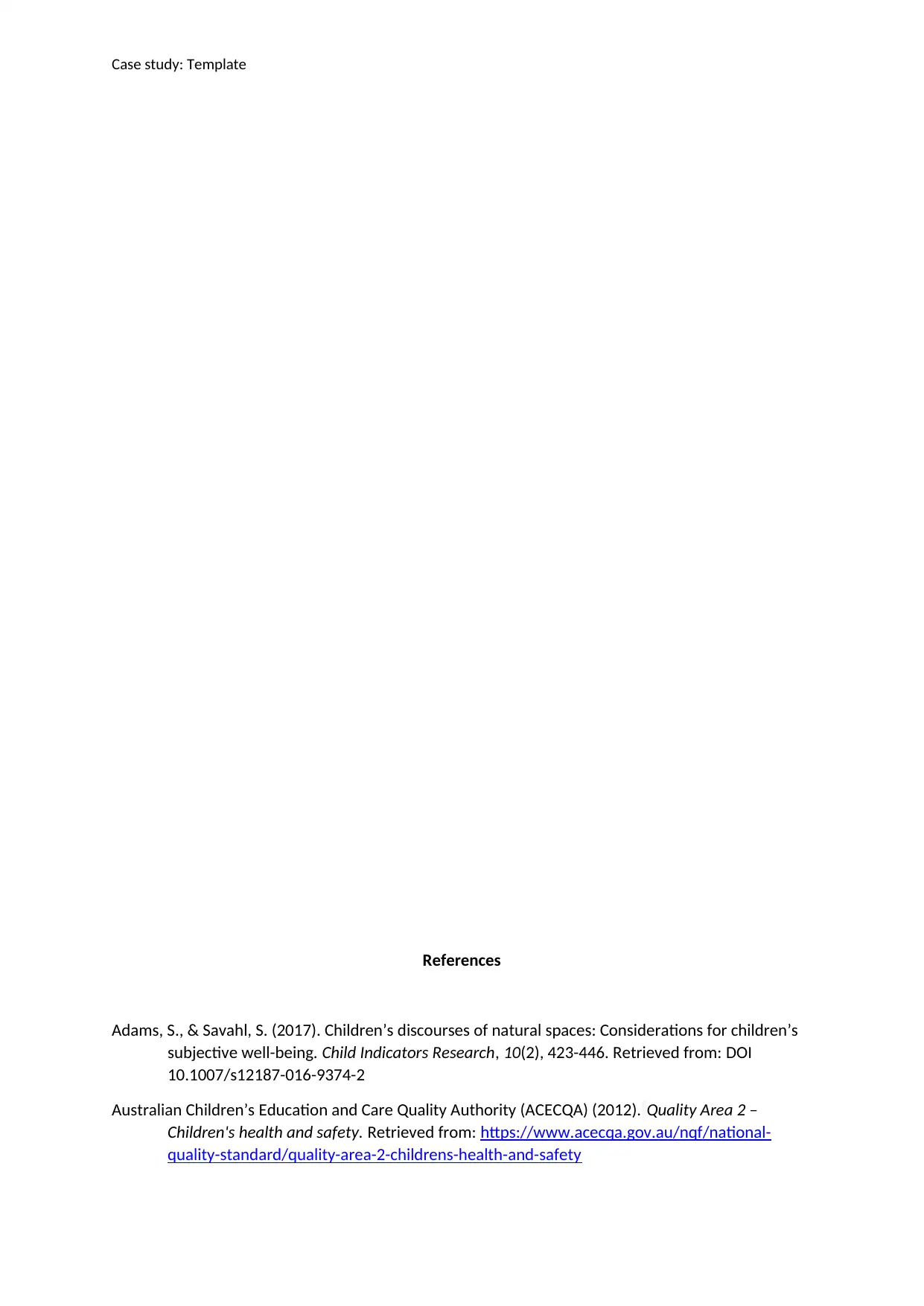
Case study: Template
References
Adams, S., & Savahl, S. (2017). Children’s discourses of natural spaces: Considerations for children’s
subjective well-being. Child Indicators Research, 10(2), 423-446. Retrieved from: DOI
10.1007/s12187-016-9374-2
Australian Children’s Education and Care Quality Authority (ACECQA) (2012). Quality Area 2 –
Children's health and safety. Retrieved from: https://www.acecqa.gov.au/nqf/national-
quality-standard/quality-area-2-childrens-health-and-safety
References
Adams, S., & Savahl, S. (2017). Children’s discourses of natural spaces: Considerations for children’s
subjective well-being. Child Indicators Research, 10(2), 423-446. Retrieved from: DOI
10.1007/s12187-016-9374-2
Australian Children’s Education and Care Quality Authority (ACECQA) (2012). Quality Area 2 –
Children's health and safety. Retrieved from: https://www.acecqa.gov.au/nqf/national-
quality-standard/quality-area-2-childrens-health-and-safety
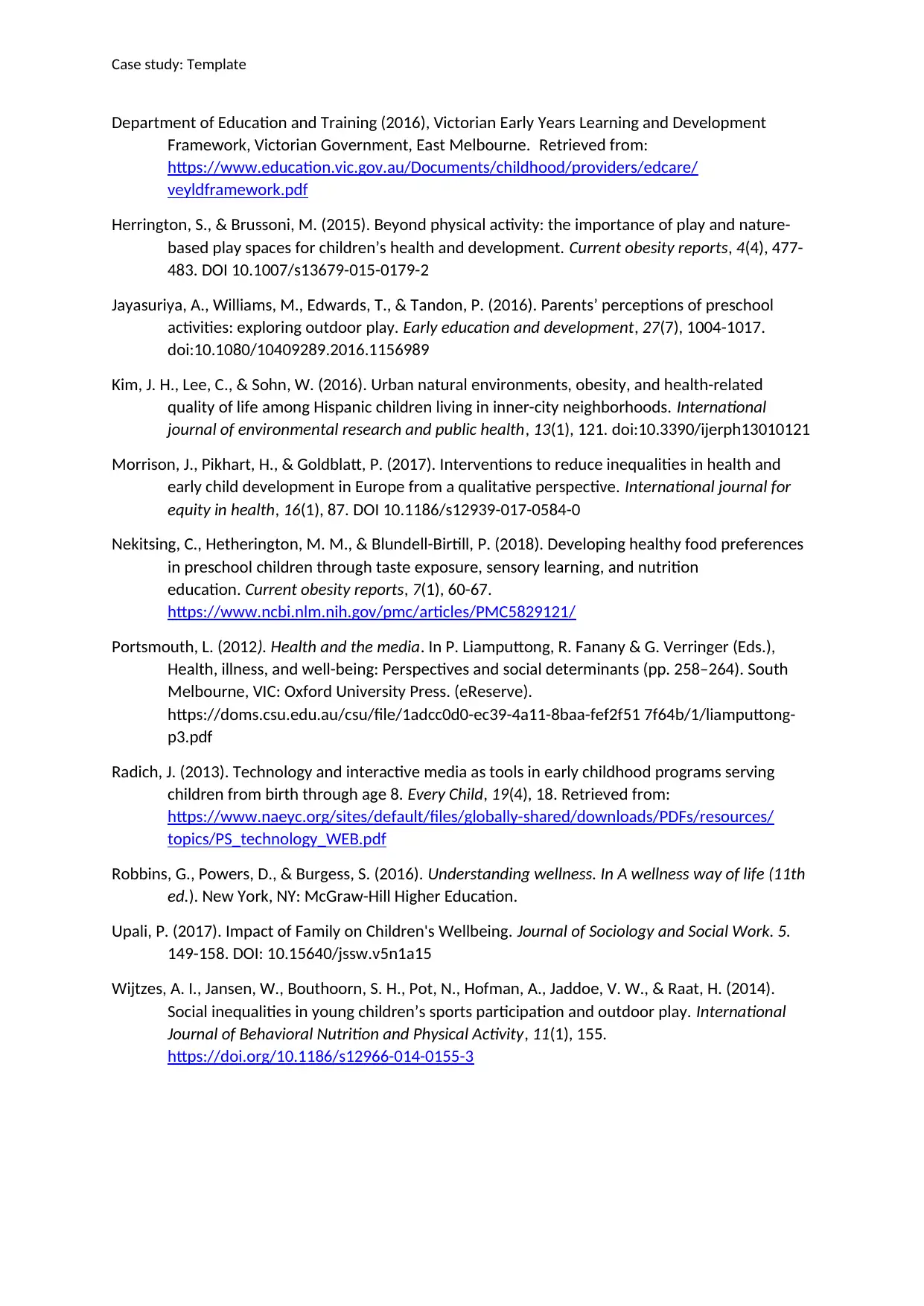
Case study: Template
Department of Education and Training (2016), Victorian Early Years Learning and Development
Framework, Victorian Government, East Melbourne. Retrieved from:
https://www.education.vic.gov.au/Documents/childhood/providers/edcare/
veyldframework.pdf
Herrington, S., & Brussoni, M. (2015). Beyond physical activity: the importance of play and nature-
based play spaces for children’s health and development. Current obesity reports, 4(4), 477-
483. DOI 10.1007/s13679-015-0179-2
Jayasuriya, A., Williams, M., Edwards, T., & Tandon, P. (2016). Parents’ perceptions of preschool
activities: exploring outdoor play. Early education and development, 27(7), 1004-1017.
doi:10.1080/10409289.2016.1156989
Kim, J. H., Lee, C., & Sohn, W. (2016). Urban natural environments, obesity, and health-related
quality of life among Hispanic children living in inner-city neighborhoods. International
journal of environmental research and public health, 13(1), 121. doi:10.3390/ijerph13010121
Morrison, J., Pikhart, H., & Goldblatt, P. (2017). Interventions to reduce inequalities in health and
early child development in Europe from a qualitative perspective. International journal for
equity in health, 16(1), 87. DOI 10.1186/s12939-017-0584-0
Nekitsing, C., Hetherington, M. M., & Blundell-Birtill, P. (2018). Developing healthy food preferences
in preschool children through taste exposure, sensory learning, and nutrition
education. Current obesity reports, 7(1), 60-67.
https://www.ncbi.nlm.nih.gov/pmc/articles/PMC5829121/
Portsmouth, L. (2012). Health and the media. In P. Liamputtong, R. Fanany & G. Verringer (Eds.),
Health, illness, and well-being: Perspectives and social determinants (pp. 258–264). South
Melbourne, VIC: Oxford University Press. (eReserve).
https://doms.csu.edu.au/csu/file/1adcc0d0-ec39-4a11-8baa-fef2f51 7f64b/1/liamputtong-
p3.pdf
Radich, J. (2013). Technology and interactive media as tools in early childhood programs serving
children from birth through age 8. Every Child, 19(4), 18. Retrieved from:
https://www.naeyc.org/sites/default/files/globally-shared/downloads/PDFs/resources/
topics/PS_technology_WEB.pdf
Robbins, G., Powers, D., & Burgess, S. (2016). Understanding wellness. In A wellness way of life (11th
ed.). New York, NY: McGraw-Hill Higher Education.
Upali, P. (2017). Impact of Family on Children's Wellbeing. Journal of Sociology and Social Work. 5.
149-158. DOI: 10.15640/jssw.v5n1a15
Wijtzes, A. I., Jansen, W., Bouthoorn, S. H., Pot, N., Hofman, A., Jaddoe, V. W., & Raat, H. (2014).
Social inequalities in young children’s sports participation and outdoor play. International
Journal of Behavioral Nutrition and Physical Activity, 11(1), 155.
https://doi.org/10.1186/s12966-014-0155-3
Department of Education and Training (2016), Victorian Early Years Learning and Development
Framework, Victorian Government, East Melbourne. Retrieved from:
https://www.education.vic.gov.au/Documents/childhood/providers/edcare/
veyldframework.pdf
Herrington, S., & Brussoni, M. (2015). Beyond physical activity: the importance of play and nature-
based play spaces for children’s health and development. Current obesity reports, 4(4), 477-
483. DOI 10.1007/s13679-015-0179-2
Jayasuriya, A., Williams, M., Edwards, T., & Tandon, P. (2016). Parents’ perceptions of preschool
activities: exploring outdoor play. Early education and development, 27(7), 1004-1017.
doi:10.1080/10409289.2016.1156989
Kim, J. H., Lee, C., & Sohn, W. (2016). Urban natural environments, obesity, and health-related
quality of life among Hispanic children living in inner-city neighborhoods. International
journal of environmental research and public health, 13(1), 121. doi:10.3390/ijerph13010121
Morrison, J., Pikhart, H., & Goldblatt, P. (2017). Interventions to reduce inequalities in health and
early child development in Europe from a qualitative perspective. International journal for
equity in health, 16(1), 87. DOI 10.1186/s12939-017-0584-0
Nekitsing, C., Hetherington, M. M., & Blundell-Birtill, P. (2018). Developing healthy food preferences
in preschool children through taste exposure, sensory learning, and nutrition
education. Current obesity reports, 7(1), 60-67.
https://www.ncbi.nlm.nih.gov/pmc/articles/PMC5829121/
Portsmouth, L. (2012). Health and the media. In P. Liamputtong, R. Fanany & G. Verringer (Eds.),
Health, illness, and well-being: Perspectives and social determinants (pp. 258–264). South
Melbourne, VIC: Oxford University Press. (eReserve).
https://doms.csu.edu.au/csu/file/1adcc0d0-ec39-4a11-8baa-fef2f51 7f64b/1/liamputtong-
p3.pdf
Radich, J. (2013). Technology and interactive media as tools in early childhood programs serving
children from birth through age 8. Every Child, 19(4), 18. Retrieved from:
https://www.naeyc.org/sites/default/files/globally-shared/downloads/PDFs/resources/
topics/PS_technology_WEB.pdf
Robbins, G., Powers, D., & Burgess, S. (2016). Understanding wellness. In A wellness way of life (11th
ed.). New York, NY: McGraw-Hill Higher Education.
Upali, P. (2017). Impact of Family on Children's Wellbeing. Journal of Sociology and Social Work. 5.
149-158. DOI: 10.15640/jssw.v5n1a15
Wijtzes, A. I., Jansen, W., Bouthoorn, S. H., Pot, N., Hofman, A., Jaddoe, V. W., & Raat, H. (2014).
Social inequalities in young children’s sports participation and outdoor play. International
Journal of Behavioral Nutrition and Physical Activity, 11(1), 155.
https://doi.org/10.1186/s12966-014-0155-3
1 out of 6
Related Documents
Your All-in-One AI-Powered Toolkit for Academic Success.
+13062052269
info@desklib.com
Available 24*7 on WhatsApp / Email
![[object Object]](/_next/static/media/star-bottom.7253800d.svg)
Unlock your academic potential
© 2024 | Zucol Services PVT LTD | All rights reserved.





